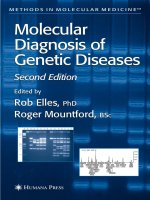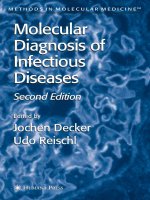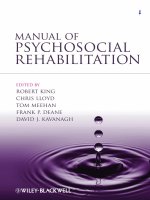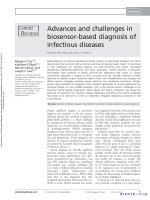- Trang chủ >>
- Y - Dược >>
- Y học công cộng
Washington manual of infectious diseases 2nd ed subspeciality consult
Bạn đang xem bản rút gọn của tài liệu. Xem và tải ngay bản đầy đủ của tài liệu tại đây (9.58 MB, 621 trang )
THE WASHINGTON MANUAL™
I
n fectio us Diseases
Su bspecial ty C o n su l t
SECO ND EDI
TI
ON
Edito rs
Nigar Kirman i, MD
Pro fesso r o f Medicine
Divisio n o f I
nfectio us Diseases
Departmento f I
nternal Medicine
Washingto n University Scho o l o f Medicine
St. Louis, Misso uri
Keith F. W o el tje, MD , Ph D
Pro fesso r o f Medicine
Divisio n o f I
nfectio us Diseases
Departmento f I
nternal Medicine
Washingto n University Scho o l o f Medicine
St. Louis, Misso uri
Hil ary M. B abco ck, MD
AssistantPro fesso r o f Medicine
Divisio n o f I
nfectio us Diseases
Departmento f I
nternal Medicine
Washingto n University Scho o l o f Medicine
St. Louis, Misso uri
Series Edito rs
Th o mas M. D e Fer, MD
Pro fesso r o f Medicine
Washingto n University Scho o l o f Medicine
St. Louis, Misso uri
Kath erin e E. Hen derso n , MD
AssistantPro fesso r o f Clinical Medicine
2
Departmento f Medicine
Washingto n University Scho o l o f Medicine
Barnes-J
ewish Ho spital
St. Louis, Misso uri
3
Senior Acquisitions Editor: Sonya Seigafuse
Senior Product Manager: Kerry Barrett
Vendor Manager: Alicia Jackson
Senior Marketing Manager: Kimberly Schonberger
Senior Manufacturing Manager: Benjamin Rivera
Editorial Coordinator: Katie Sharp
Design Coordinator: Stephen Druding
Production Service: Integra Software Services Pvt. Ltd.
© 2013 by Department of Medicine, Washington University School of Medicine
Printed in China
All rights reserved. This book is protected by copyright. No part of this book may be reproduced in any form by
any means, including photocopying, or utilized by any information storage and retrieval system without written
permission from the copyright owner, except for brief quotations embodied in critical articles and reviews.
Materials appearing in this book prepared by individuals as part of their official duties as U.S. government
employees are not covered by the above-mentioned copyright.
Library of Congress Cataloging-in-Publication Data
The Washington manual infectious diseases subspecialty consult. —2nd ed. / editors, Nigar Kirmani, Keith F.
Woeltje, Hilary M. Babcock.
p. ; cm. — (Washington manual subspecialty consult series)
Infectious diseases subspecialty consult
Includes bibliographical references and index.
ISBN 978-1-4511-1364-8 — ISBN 1-4511-1364-1
I. Kirmani, Nigar. II. Woeltje, Keith F. III. Babcock, Hilary. IV. Washington University (Saint Louis, Mo.).
School of Medicine. V. Title: Infectious diseases subspecialty consult. VI. Series: Washington manual subspecialty
consult series.
[DNLM: 1. Communicable Diseases—Handbooks. 2. Diagnosis, Differential—Handbooks. 3. Patient Care
Planning—Handbooks. WC 39]
616.9—dc23
2012025731
The Washington Manual™ is an intent-to-use mark belonging to Washington University in St. Louis to which
international legal protection applies. The mark is used in this publication by LWW under license from Washington
University.
Care has been taken to confirm the accuracy of the information presented and to describe generally accepted
practices. However, the authors, editors, and publisher are not responsible for errors or omissions or for any
consequences from application of the information in this book and make no warranty, expressed or implied, with
respect to the currency, completeness, or accuracy of the contents of the publication. Application of the
information in a particular situation remains the professional responsibility of the practitioner.
The authors, editors, and publisher have exerted every effort to ensure that drug selection and dosage set forth
in this text are in accordance with current recommendations and practice at the time of publication. However, in
view of ongoing research, changes in government regulations, and the constant flow of information relating to drug
therapy and drug reactions, the reader is urged to check the package insert for each drug for any change in
indications and dosage and for added warnings and precautions. This is particularly important when the
4
recommended agent is a new or infrequently employed drug.
Some drugs and medical devices presented in the publication have Food and Drug Administration (FDA)
clearance for limited use in restricted research settings. It is the responsibility of the health care provider to
ascertain the FDA status of each drug or device planned for use in their clinical practice.
To purchase additional copies of this book, call our customer service department at (800) 638-3030 or fax orders
to (301) 223-2320. International customers should call (301) 223-2300.
Visit Lippincott Williams & Wilkins on the Internet: at LWW.com. Lippincott Williams & Wilkins customer
service representatives are available from 8:30 am to 6 pm, EST.
10 9 8 7 6 5 4 3 2 1
5
Contributing Authors
Hil ary M. Babco ck, MD
AssistantPro fesso r o f Medicine
Divisio n o f I
nfectio us Diseases
Departmento f I
nternal Medicine
Washingto n University Scho o l o f Medicine
St. Louis, Misso uri
Tho mas C. Bail ey, MD
Pro fesso r o f Medicine
Divisio n o f I
nfectio us Diseases
Departmento f I
nternal Medicine
Washingto n University Scho o l o f Medicine
St. Louis, Misso uri
Erik R. Dubberke, MD
AssistantPro fesso r o f Medicine
Divisio n o f I
nfectio us Diseases
Departmento f I
nternal Medicine
Washingto n University Scho o l o f Medicine
St. Louis, Misso uri
Michael J. Durkin , MD
I
nstructo r in Medicine
Divisio n o f I
nfectio us Diseases
Departmento f I
nternal Medicine
Washingto n University Scho o l o f Medicine
St. Louis, Misso uri
Jessica R. Grubb, MD
AssistantPro fesso r o f Medicine
Divisio n o f I
nfectio us Diseases
Departmento f I
nternal Medicine
Washingto n University Scho o l o f Medicine
6
St. Louis, Misso uri
José E. Hagan , MD
Clinical Fello w
Divisio n o f I
nfectio us Diseases
Departmento f I
nternal Medicine
Washingto n University Scho o l o f Medicine
St. Louis, Misso uri
Zhuo l in Han , MD
Clinical Fello w
Divisio n o f I
nfectio us Diseases
Departmento f I
nternal Medicine
Washingto n University Scho o l o f Medicine
St. Louis, Misso uri
Jeffrey P. Hen derso n , MD
AssistantPro fesso r o f Medicine
Divisio n o f I
nfectio us Diseases
Departmento f I
nternal Medicine
Washingto n University Scho o l o f Medicine
St. Louis, Misso uri
Hito shi Ho n da, MD
Clinical Fello w
Divisio n o f I
nfectio us Diseases
Departmento f I
nternal Medicine
Washingto n University Scho o l o f Medicine
St. Louis, Misso uri
Cyn thia John so n , MD
Clinical Fello w
Divisio n o f I
nfectio us Diseases
Departmento f I
nternal Medicine
Washingto n University Scho o l o f Medicine
St. Louis, Misso uri
Amel ia M. Kasper, MD
Resident
7
Divisio n o f I
nfectio us Diseases
Departmento f I
nternal Medicine
Washingto n University Scho o l o f Medicine
St. Louis, Misso uri
Nigar Kirman i, MD
Pro fesso r o f Medicine
Divisio n o f I
nfectio us Diseases
Departmento f I
nternal Medicine
Washingto n University Scho o l o f Medicine
St. Louis, Misso uri
Ro byn S. Kl ein , MD
Asso ciate Pro fesso r o f Medicine
Divisio n o f I
nfectio us Diseases
Departmento f I
nternal Medicine
Washingto n University Scho o l o f Medicine
St. Louis, Misso uri
F. Matthew Kuhl man n , MD
I
nstructo r o f Medicine
Divisio n o f I
nfectio us Diseases
Departmento f I
nternal Medicine
Washingto n University Scho o l o f Medicine
St. Louis, Misso uri
Michael A. Lan e, MD
AssistantPro fesso r o f Medicine
Divisio n o f I
nfectio us Diseases
Departmento f I
nternal Medicine
Washingto n University Scho o l o f Medicine
St. Louis, Misso uri
Steven J. Lawren ce, MD
AssistantPro fesso r o f Medicine
Divisio n o f I
nfectio us Diseases
Departmento f I
nternal Medicine
Washingto n University Scho o l o f Medicine
St. Louis, Misso uri
8
Susan a Lazarte, MD
Clinical Fello w
Divisio n o f I
nfectio us Diseases
Departmento f I
nternal Medicine
Washingto n University Scho o l o f Medicine
St. Louis, Misso uri
Stephen Y . Lian g, MD
Clinical Fello w
Divisio n o f I
nfectio us Diseases
Departmento f I
nternal Medicine
Washingto n University Scho o l o f Medicine
St. Louis, Misso uri
Luis A. Marco s, MD
Clinical Fello w
Divisio n o f I
nfectio us Diseases
Departmento f I
nternal Medicine
Washingto n University Scho o l o f Medicine
St. Louis, Misso uri
Jon as Marschal l , MD
AssistantPro fesso r o f Medicine
Divisio n o f I
nfectio us Diseases
Departmento f I
nternal Medicine
Washingto n University Scho o l o f Medicine
St. Louis, Misso uri
Jay R. McDo n al d, MD
AssistantPro fesso r o f Medicine
Divisio n o f I
nfectio us Diseases
Departmento f I
nternal Medicine
Washingto n University Scho o l o f Medicine
St. Louis, Misso uri
Dian a Nurutdin o va, MD
I
nstructo r in Medicine
Divisio n o f I
nfectio us Diseases
Departmento f I
nternal Medicine
9
Washingto n University Scho o l o f Medicine
St. Louis, Misso uri
Rachel Presti, MD
AssistantPro fesso r o f Medicine
Divisio n o f I
nfectio us Diseases
Departmento f I
nternal Medicine
Washingto n University Scho o l o f Medicine
St. Louis, Misso uri
Hil ary Ren o , MD
I
nstructo r in Medicine
Divisio n o f I
nfectio us Diseases
Departmento f I
nternal Medicine
Washingto n University Scho o l o f Medicine
St. Louis, Misso uri
David J. Riddl e, MD
I
nstructo r in Medicine
Divisio n o f I
nfectio us Diseases
Departmento f I
nternal Medicine
Washingto n University Scho o l o f Medicine
St. Louis, Misso uri
David J. Ritchie, PharmD
Clinical Pharmacist, I
nfectio us Diseases
Barnes-J
ewish Ho spital
Pro fesso r o f Pharmacy Practice
St. Louis Co llege o f Pharmacy
St. Louis, Misso uri
Carl o s San to s, MD
AssistantPro fesso r o f Medicine
Divisio n o f I
nfectio us Diseases
Departmento f I
nternal Medicine
Washingto n University Scho o l o f Medicine
St. Louis, Misso uri
Mo l l y F. Sariko n da, MD
10
Clinical Fello w
Divisio n o f I
nfectio us Diseases
Departmento f I
nternal Medicine
Washingto n University Scho o l o f Medicine
St. Louis, Misso uri
To shibumi Tan iguchi, MD
Clinical Fello w
Divisio n o f I
nfectio us Diseases
Departmento f I
nternal Medicine
Washingto n University Scho o l o f Medicine
St. Louis, Misso uri
Bren t W. Wiel an d, MD
Clinical Fello w
Divisio n o f I
nfectio us Diseases
Departmento f I
nternal Medicine
Washingto n University Scho o l o f Medicine
St. Louis, Misso uri
Keith F. Wo el tje, MD, PhD
Pro fesso r o f Medicine
Divisio n o f I
nfectio us Diseases
Departmento f I
nternal Medicine
Washingto n University Scho o l o f Medicine
St. Louis, Misso uri
11
Chairman’s Note
t is a pleasure to present the new edition of The Washington Manual™
Subspecialty Consult Series: Infectious Diseases Subspecialty Consult.
This pocket-size book continues to be a primary reference for medical students,
interns, residents, and other practitioners who need ready access to practical clinical
information to diagnose and treat patients with a wide variety of disorders. Medical
knowledge continues to increase at an astounding rate, which creates a challenge for
physicians to keep up with the biomedical discoveries, genetic and genomic
information, and novel therapeutics that can positively impact patient outcomes. The
Washington Manual Subspecialty Series addresses this challenge by concisely and
practically providing current scientific information for clinicians to aid them in the
diagnosis, investigation, and treatment of common medical conditions.
I want to personally thank the authors, who include house officers, fellows, and
attendings at Washington University School of Medicine and Barnes-Jewish
Hospital. Their commitment to patient care and education is unsurpassed, and their
efforts and skill in compiling this manual are evident in the quality of the final
product. In particular, I would like to acknowledge our editors, Drs. Nigar Kirmani,
Keith Woeltje, and Hilary Babcock, and the series editors, Drs. Tom De Fer and
Katherine Henderson, who have worked tirelessly to produce another outstanding
edition of this manual. I would also like to thank Dr. Melvin Blanchard, Chief of the
Division of Medical Education in the Department of Medicine at Washington
University School of Medicine, for his advice and guidance. I believe this
Subspecialty Manual will meet its desired goal of providing practical knowledge
that can be directly applied at the bedside and in outpatient settings to improve
patient care.
I
Victoria J. Fraser, MD
Dr. J. William Campbell Professor
Interim Chairman of Medicine
Codirector of the Infectious Disease Division
Washington University School of Medicine
12
Preface
e are delighted to introduce the long-awaited second edition of The
Washington Manual ™ Infectious Diseases Subspecialty Consult. The
chapters have been contributed primarily by faculty and fellows from the Infectious
Diseases Division in the Department of Internal Medicine at the Washington
University School of Medicine in St. Louis.
Infectious disease is an exciting field in constant evolution. Even since the
release of the first edition of this manual, there have been new diseases, new
diagnostic methods, and new treatment challenges with the development of multipledrug–resistant organisms. There continues to be a need for specialists in this field.
Infectious disease specialists treat patients of all ages, deal with all organ systems,
and collaborate with nearly all other medical specialties and subspecialties. In
infectious disease, no case is exactly the same, so there is no “cookbook” approach
to these problems. This makes each case intriguing, and even the most mundane
cases have appeal. It is our hope that this manual stimulates interest in infectious
disease among its readers and inspires them to pursue a career in this specialty.
This manual complements the Washington Manual of Medical Therapeutics by
providing more in-depth coverage of infectious diseases. We have focused on
providing easy-to-follow guidance for the diagnosis and treatment of infectious
diseases likely to be seen by medical house officers and hospitalists. Diseases are
organized primarily by organ system to facilitate generating a useful differential
diagnosis based on a patient’s presentation. By providing practical guidance for
common problems, the manual serves not as a comprehensive textbook, but rather as
a go-to reference that can be kept handy on the wards.
It should be noted that the dosing information in the text assumes normal renal
function unless otherwise indicated. Dosing information for impaired renal function
is available in Chapter 20: Antimicrobial Agents.
We would like to offer special thanks to Katie Sharp for her extensive assistance
in keeping the project organized and moving forward. This book wouldn’t have been
possible without her. We would also like to thank Dr. Tom De Fer in the Department
of Medicine for his editorial guidance. And finally we’d like to recognize Dr.
Victoria Fraser, the J. William Campbell Professor in the Department of Medicine.
She is an outstanding clinician, researcher, and administrator. Initially as a faculty
member, then as cochief of the Infectious Diseases Division, and now as Chair of
Medicine, her mentorship has been invaluable. Thanks for everything, Vicky, even if
W
13
it is exhausting trying to keep up with you.
N.K.
K.F.W.
H.M.B.
14
Contents
Co ntributing Autho rs
Chairman’s No te
Preface
1. Appro ach to the I
nfectio us Disease Co nsul tatio n
F. Matthew Kuhlmann and Hilary M. Babco ck
2. The Acute Febril e Patientand Sepsis
Stephen Y. Liang and J
ay R.McDo nald
3. Fever o f Unkno wn Origin
Stephen Y. Liang and Nigar Kirmani
4. Bacteremia and I
nfectio ns o f the Cardio vascul ar Systems
BrentW. Wieland and Rachel Presti
5. Respirato ry I
nfectio ns
Michael J
. Durkin, Tho mas C. Bailey, and Michael A. Lane
6. I
nfectio ns o f the Gastro intestinal and Hepato bil iary Tract
Zhuo lin Han and ErikR.Dubberke
7. Urinary TractI
nfectio ns
Amelia M. Kasper and J
effrey P. Henderso n
8. I
nfectio ns o f the Bo ne and J
o int
Mo lly F. Sariko nda and J
o nas Marschall
9. Skin and So ftTissue I
nfectio ns
Mo lly F. Sariko nda and David J
. Riddle
10. Central Nervo us System I
nfectio ns
Susana Lazarte and Robyn S. Klein
15
11. Sexual l y Transmitted I
nfectio ns
Amelia M. Kasper and Hilary Reno
12. Human I
mmuno deficiency Virus I
nfectio n
To shibumi Taniguchi and Diana Nurutdino va
13. Oppo rtunistic I
nfectio ns Asso ciated with HI
V
To shibumi Taniguchi and J
essica R.Grubb
14. I
nfectio n in No n-HI
VI
mmuno co mpro mised Ho sts
Cynthia J
o hnso n and Carlo s Santo s
15. Endemic Myco ses
BrentW. Wieland and Keith F. Wo eltje
16. Zo o no tic I
nfectio ns and Ecto parasites
J
o sé E. Hagan and Steven J
. Lawrence
17. Pro to zo al I
nfectio n
Luis A. Marco s and F. Matthew Kuhlmann
18. Hel minthic I
nfectio ns
Luis A. Marco s and F. Matthew Kuhlmann
19. I
nfectio n Preventio n
Hito shi Ho nda and Hilary M. Babco ck
20. Antimicro bial Agents
David J
. Ritchie and Nigar Kirmani
I
ndex
16
1 Approach to the Infectious Disease
Consultation
F. Matthew Kuhl man n an d Hil ary M. Babco ck
GENERALPRI
NCI
PLES
The greatest challenge in the infectious disease consultation is the breadth of the
subspecialty. Disease manifestations involve all specialties and organ systems.
Infectious disease consultation requires thorough evaluation, organized thought
processes, and an ability to appropriately consider rare but significant diagnoses.
Four general categories of infectious disease consults
Diagnostic dilemmas are by far the most challenging consultation; they are
classified as consults where a diagnosis remains elusive. Types of consults
include evaluations for fever of unknown origin and other seemingly mysterious
illnesses. Thorough evaluation and history describing details of the patient’s
potential exposures is critical.
Therapeutic management involves management of a specific infection as it
relates to the overall care of the patient, such as an infected knee implant.
Antibiotic management ensures appropriate choice, dose, and duration of
antibiotics for a given infection.
Occupational health and infection prevention ensure the health of employees,
patients, and visitors within health care facilities.
The ten commandments for effective consultation
Established in 1983 by Goldman and others and modified by Salerno in 2007, the
following rules provide a framework for effective patient care and communication
with requesting physicians.1,2 Knowing the specific expectations of the requesting
physician allows you to address the concerns leading to the consultation. Always
remember that a physician requests a service from the consultant much like a
consumer buys products from a vendor.
Determine your customer. Are you providing management for a surgeon or
guidance for an internist? What specific question should be answered?
Establish urgency. How quickly should the patient be seen? Several potential
infectious diseases, such as necrotizing fasciitis or cerebral malaria, require
emergent consultation to initiate proper therapy.
Look for yourself. Although one does not need to repeat every excruciating
detail in written consultation, each important detail should be reconfirmed.
17
Be as brief as appropriate. Write concise assessments that adequately explain
your rationale.
Be specific and humble. Write clear plans. Provide help in executing the plans
when requested. Such help may include order writing or obtaining additional
information from hospitals or health departments.
Provide contingency plans. Determine likely problems and provide guidance
for their remediation. Provide around-the-clock contact information in order to
assist in addressing such problems when they arise.
Determine the appropriate level of management. How much should you
intervene regarding order writing and dictating patient care? This should be
negotiated with the requesting physician during initial discussions.
Teach with tact and pragmatism. Provide educational materials or discussions
appropriate to the given situation.
Talk is essential. Always call the requesting physician with your
recommendations.
Follow up daily. Daily written notes should be provided until problems are no
longer active as determined by yourself and the requesting physician. Provide
appropriate long-term follow-up care.
“Curbside” consultation
Frequently, requesting physicians ask for opinions based on limited conversation.
Such consultations, called “curbside consultations,” are considered a courtesy and
promote collegiality. When providing curbside consultation, one should always
speak in general terms and avoid providing absolute recommendations.
Frequently, important historical details are unintentionally omitted, limiting the
ability to provide accurate advice. Generalized guidelines for providing curbside
consultation are provided below.
Appropriate for curbside consultation
Dose or duration of antibiotics for simple infections
Choice of antibiotics for simple infections
Inappropriate for curbside consultation
Complex patient problems
Uncertainty regarding question asked by the requesting physician
Infections due to highly resistant organisms, rare organisms, or bloodstream
infections
Patient concerns
Many patients may feel that additional questioning by a consultant is redundant or
insulting. Frequently, a thorough review of the written record followed by
empathetic consultations will provide improved rapport with the patient. The
following suggestions may be beneficial in alleviating patient fear:
18
Advise patients that you are visiting them on the request of their primary
physician and that you will work closely with that physician to provide the best
care possible.
Consider telling the patient that you have reviewed his/her history and have
additional specific questions that you would like to ask before providing an
opinion on his/her care.
Ask the patient to confirm your brief understanding of his/her history and to
supplement information with important details. After the initial conversation,
specific or open-ended questions regarding the history of the patient’s illness
can be asked.
Do not provide information that directly contradicts the clinical care of the
primary provider. Reasons for following a specific care plan may not be readily
apparent at the time of the patient encounter and should be clarified with the
requesting physician prior to instituting changes.
STRUCTURE O F CO NSULT NO TES
Consult notes are written in a fashion similar to the admission history and physical.
Details relating to specific sections follow.
History of present illness (HPI). The admission HPI provides the structure for
the consultation HPI. Provide a thorough review of the patient’s current illness
(onset, severity, duration, location, etc.) and hospital course. Specific details of
positive findings or pertinent negative findings from the review of systems, past
medical/surgical history, family history, and social history should be included.
Review of systems. A thorough review of systems should be obtained. Patients
may forget to include significant history in their initial encounters. Such details
may provide additional information leading to a diagnosis.
Past medical and surgical history
Specific details should be summarized in the HPI, with additional information
supplemented in the body of the consultation note.
Review detailed histories of immunosuppression due to illness or medications.
Details of surgeries and surgical findings related to infections should be
summarized.
Pertinent vaccination history can be summarized.
Medications
Review histories of any antimicrobial therapy that has been administered in the
past several months. Note doses, durations, and any available drug levels.
Any immunosuppressive medications should be noted.
Note drugs that frequently interact with antimicrobials, especially warfarin.
19
Allergies. Note not only the drugs, especially antibiotics, but also the type of
reaction (rash vs. anaphylaxis, etc.).
Social history. This section could be alternatively named exposure history, as
many behaviors place patients at risk for specific infections. General topics to
review include the following:
Living environment. In what geographical region does the patient reside? Does
the patient live in a stable home or is he/she homeless? Does the patient live in
an urban or rural environment?
Work history. Different jobs involve exposures to various infectious or toxic
agents.
Animals. Specific zoonoses can be diagnosed based on the exposures to certain
domestic or wild animals.
Travel history. The patient may have traveled to areas that harbor specific
infections, even within their native country. Any travel history over a patient’s
lifetime may be considered important.
Sexual history. The number of partners places a patient at risk for sexually
transmitted infections, and the nature of such interactions may be important,
leading to additional diagnoses, e.g., oropharyngeal gonococcal infections.
Physical exam. A detailed exam can provide additional clues to the cause of a
patient’s illness or complications from a patient’s medical interventions. Rashes
are highly indicative of specific infections or toxicities from antibiotics. Thorough
dermatological, oral, ocular, and lymph node exams are especially important.
Detailed descriptions of infected lesions remain essential.
Data
One should review all serological, radiological, and pathological studies and
consider reviewing the data with the microbiologist, radiologist, or pathologist.
Trends in routine chemistries should be described, as they are much more
informative than one isolated time point. Note the differential on complete blood
counts as neutropenia and lymphopenia are not evident from the total blood cell
count. For patients receiving long-term antibiotics, recent liver function testing
should be noted.
Note specific details of microbiological culture data, both positive and negative
cultures.
Site of collection (e.g., peripheral vs. central line, right arm vs. left arm,
specific drains)
Time of collection
Full susceptibility profiles
All identified microorganisms
Especially note any prior serological data such as viral, fungal, or bacterial
20
antibody titers.
Assessment. Summarize the case and describe the rationale for your
recommendations as noted in the ten commandments for effective consultation;
communicate your assessment directly to the requesting physician.
Plan. Outline your recommendations in an easy-to-read format, supplement with
details only if they are not provided in your assessment.
REFERENCES
1. Goldman L, Lee T, Rudd P. Ten commandments for effective consultations. Arch Intern Med.
1983;143:1753-1755.
2. Salerno SM, Hurst FP, Halvorson S, Mercado DL. Principles of effective consultation: an update for the 21stcentury consultant. Arch Intern Med. 2007;167:271-275.
21
2 The Acute Febrile Patient and Sepsis
Stephen Y . Lian g an d Jay R. McDo n al d
APPRO AC H TO THE AC U TE FEB RI
LE PATI
ENT
GENERALPRI
NCI
PLES
Defin itio n
Fever has classically been defined as a body temperature of ≥38.0°C (100.4°F).
Recent evidence suggests that the upper limit of normal oral temperature may be
37.2°C (98.9°F) in the early morning and 37.7°C (99.9°F) overall in healthy
adults, though significant variability exists between individuals.1
Febrile response in the elderly patient is frequently blunted, leading some to
define fever in this population as a persistent oral temperature ≥37.2°C (98.9°F),
rectal temperature ≥37.5°C (99.5°F), or a rise in temperature of ≥1.3°C (2.3°F)
above baseline.2
Oral temperatures are generally 0.4°C (0.7°F) lower than rectal temperatures.
Axillary and tympanic temperatures may be unreliable.
Etio l o gy
Infectious causes of fever lasting less than 2 weeks are legion and may range from
self-limited viral to serious bacterial infections. Differential diagnosis hinges
heavily upon the history and physical examination. Fevers of unknown origin
lasting more than 3 weeks are discussed in Chapter 3.
Noninfectious causes of fever may include neoplastic, rheumatologic, endocrine,
thromboembolic, and medication-related disorders.
While hyperpyrexia (>41.5°C or 106.7°F) may be encountered with severe
infection, it is more common with central nervous system hemorrhage.
Hyperthermia is a distinct entity apart from fever and may result from
environmental factors, endocrine disorders (hyperthyroidism), and certain
medications (e.g., anesthetics, neuroleptic agents, recreational drugs).
Patho physio l o gy
Thermoregulation is mediated by the hypothalamus.
Exogenous pyrogens (e.g., microbes, toxins) induce host macrophages and other
phagocytic cells, triggering the release of endogenous cytokines (e.g., interleukin
22
[IL]-1, IL-6, tumor necrosis factor [TNF]-α, interferons).
These endogenous pyrogens modulate an inflammatory acute phase response and
promote prostaglandin E2 (PGE2) synthesis. It is thought that PGE2 acts upon the
hypothalamus, precipitating a rise in body temperature.
DI
AGNO SI
S
Cl in ical Presen tatio n
Histo ry
Clarify the patient’s definition of “fever,” whether it is subjective, tactile, or
measured, and if so, by what route. Characterize the magnitude, duration, and
consistency of the fever.
Establish a time line of all symptoms in relation to the start of the fever. While
the cause may be obvious in many cases, a thorough review of systems may
uncover additional symptomatology characteristic of specific infections (e.g.,
myalgias, rashes, lymphadenopathy). Look for temporal relationships between
fever and medical interventions (e.g., surgeries, catheters, mechanical ventilation,
antibiotics, prolonged hospitalizations).
Ascertain the immune status of the patient. Neoplasm, chemotherapy,
immunosuppressive therapy (to prevent transplant rejection or treat rheumatologic
disorders), corticosteroid use, human immunodeficiency virus (HIV) infection, and
primary immunodeficiency disease (e.g., humoral immune or severe combined
immunodeficiencies) all influence the spectrum of infections possible.
Obtain a complete past medical history, surgical history (including all prosthetics,
foreign materials, and implantable devices), and medication list (prescription,
over-the-counter, alternative). Use of antipyretics should be noted. When
available, a vaccination record should be reviewed, particularly in asplenic and
immunocompromised patients.
A social history should identify environmental, occupational, recreational, sexual,
dietary, animal, and travel exposures as well as sick contacts.
Family members can frequently provide additional insight into the patient’s illness
and exposure history.
Physical Examinatio n
A thorough and methodical approach to the physical examination helps ensure that
subtle findings are not missed (see Table 2-1).
Febril e Syn dro mes
When used in conjunction with the history and physical, common febrile
23
syndromes help guide the differential diagnosis by suggesting organ-specific
disease processes.
Fever and headache is concerning for meningitis, while fever with focal
neurological deficits or seizure may suggest encephalitis, cerebral abscess,
subdural empyema, or epidural abscess.
Fever and chest pain mandates a search for pneumonia, but may also be seen with
pericarditis, esophagitis, and mediastinitis.
Depending on the location and history, fever and abdominal pain may raise the
suspicion of cholecystitis, appendicitis, intra-abdominal abscess, peritonitis,
diverticulitis, colitis, or a host of other pathologies.
Other febrile syndromes (e.g., rash [Table 2-2], lymphadenopathy [Table 2-3],
jaundice, and splenomegaly) may be indicative of an underlying systemic infection
(Table 2-4).
TAB LE 2 -1
PHY SI
C ALEXAMI
NATI
O N FI
ND I
NGS AND C LI
NI
C ALSY ND RO MES TO C O NSI
D ERI
N
THE PATI
ENT W I
TH FEVER
Lo catio n
Fin din gs an d asso ciatio n s
Eyes
Retinitis and o ther lesio ns (e.g., Roth spo ts), uveitis, hypo pyo n, co njunctival
suffusio n/hemo rrhage, co njunctivitis, visual field deficits
Ears
Otitis media/externa, masto iditis
Face, no se, thro at
Sinus tenderness, pharyngitis (erythema, exudate), muco sal lesio ns, thrush, perio do ntitis,
perito nsillar abscess, muffled vo ice (epiglo ttitis)
Neck
Neckstiffness (meningitis, retro pharyngeal abscess), tenderness alo ng the sterno cleido masto id
muscle (internal jugular septic thro mbo phlebitis), thyro megaly
Heart
Murmurs (endo carditis), rubs, distantso unds
Lungs
Crackles, rho nchi, wheezes, dullness to percussio n
Abdo men
Fo cal tenderness, perito neal signs, hepato megaly, spleno megaly, ascites
Genito urinary/rectum
Male: urethritis, pro statitis, o rchitis, epididymitis
Female: cervicitis, adnexal mass/tenderness, fo reign bo dy (e.g., tampo n)
Rectum: perirectal fluctuance (abscess), ulcers, Fo urnier gangrene
Back
Pressure so res, decubitus ulcers, co sto vertebral angle tenderness
Extremities
Stigmata o f endo carditis (Osler no des, J
aneway lesio ns, splinter hemo rrhages), clubbing,
palmar/plantar rashes, trackmarks
Neuro
Altered mental status, fo cal neuro lo gic deficits, ataxia
24
Skin
Cellulitis, cutaneo us abscess, sinus tracts, crepitus, necro tizing so fttissue infectio n, rash
(petechiae, purpura, macules, papules, vesicles, ulcers, eschars)
Musculo skeletal
Effusio n, septic arthritis, spino us pro cess tenderness
Lymph
Any lymphadeno pathy, lymph no de fluctuance o r drainage
Devices
Pacemaker/defibrillato r, tunneled intraveno us catheter, implantable po rt, o rtho pedic hardware
Diagn o stic Testin g
Labo rato ries
Initial testing
Laboratory evaluation of fever should be driven by the nature and severity of the
patient’s symptoms. In the inpatient setting, the following tests are a reasonable
starting point to screen for abnormalities:
Complete blood count with differential (leukocytosis, neutrophilia, bandemia,
neutropenia, anemia, thrombocytopenia)
Metabolic panel (hyponatremia, acidosis, impaired renal function)
25









